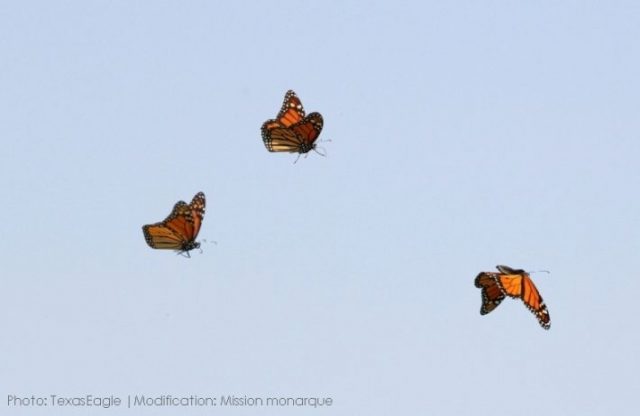Mission monarch coordinator
The monarchs of North America are known for their spectacular annual migration from Canada to Mexico. Each fall, the butterflies undertake a 4000 km journey to the oyamel fir forests, in central Mexico, where they spend the winter. Once spring arrives, they are off again for a northern migration that will spread over several generations.
If the distance traveled by the monarchs is impressive, their ability to find their way is no less! How do monarchs navigate to their destination, year after year?
A sophisticated internal compass
Not all monarchs are drawned to the South. In experiments using a flight simulator, only the “fall” butterflies demonstrated a clear direction in flight. Instinctively, they head southwest.
Migratory monarchs rely on the sun to know the direction to follow. However, since its position changes during the day, the simple observation of the sun is not enough. Imagine the zig-zag that a butterfly would do just by following the sun, every day, from east to west!
To solve this problem, migratory monarchs rely on a biological clock, located in the antennas. This clock tells them the time of day. With this information, the butterflies can adjust their position relative to the sun, in order to maintain the course towards the southwest: in the morning, they keep the sun to their left and in the afternoon, to their right.
These two combined information – the position of the sun and the time of day – constitute the internal compass enabling the monarchs to navigate to Mexico.
What about cloudy days?
Occasionally clouds hide the sun, depriving the monarchs of their visual cue. Fortunately, butterflies have more than one trick up their sleeve!
In addition to the biological clock, the indispensable antennas of the butterfly contain a “magnetic compass”. This tool tells monarchs where they are in relation to the equator. They can therefore find their way to the south by relying on the lines of the earth’s magnetic field. Impressive, right?
Heading north!
In spring, everything changes! The monarchs who spent the winter in Mexico go on migration, but this time, in the opposite direction. The same mechanism comes in, but with a major change: the internal compass has been recalibrated, during the winter, to indicate the north. It is believed that exposure to cold triggers this recalibration.
Several mysteries still surround the navigation methods of monarchs and each season unveils new answers. Certainly, these great travelers will never cease to amaze us!
More articles
- The monarch and the painted lady: do you know how to differentiate them?
- A breath taking Blitz
- The monarch, an endangered species?



9 comments